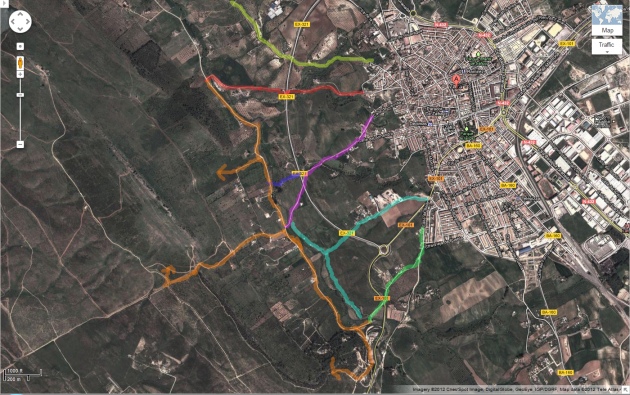Hisn al-Sajra: the forgotten castle
March 23, 2012 Leave a comment
Perched atop and in the center of la sierra mayor are the remains of a Moorish fortress. It’s name was Hisn al-Sajra, which is Zafra’s namesake. The fortress is deteriorating rapidly and will not be visible in fifty years, I’d guess; all that’s left are some half-buried foundations. I understand from reading “La Sierra del Castellar: La Historia Oculta de Zafra” by Jose Antonio Amador Redondo and Francisco Guzman Guzman that it was among a series of hill-forts built to protect the Guadiana valley (around Merida) from attacks by Cordoba and Sevilla during the early middle ages, when the Moors ruled this part of the Iberian peninsula. There is also some indication that the Moors built Hisn al-Sajra atop an earlier settlement (Roman?) but that, also, may have been built atop yet another settlement (ad infinitum) from the Bronze age. We have reason to believe that the top of the Castellar has drawn human attention for many thousands of years.
The top of the mountain is a mess of broken roof-tiles and pot sherds. I will detail some of the more impressive examples we’ve found in the “Artifacts” series of posts. On the surface it sounds irresponsible to remove anything from the various sites on the mountain, but the ground has suffered (and continues to suffer) hundreds of years of ploughing and livestock traffic. The ground is in places totally obscured beneath a carpet of goat and sheep droppings, and the cows haven’t been any less discreet. In a way, the overall poor quality of the site for archaeological examination and the manner in which the ground is constantly churned have helped us feel less guilty about our disruptive attempts to preserve some record of the fortress.
In the image above and the image below I’ve marked some points of interest. They are:
[1]la esquina (the corner) – This is the elbow in a little access road which permits us easy access to the mountainside. The fence-corner isn’t closed, so anyone (and any sheep) might simply slip through at will.
[2] guard tower – now I’m questioning the placement of this marker; it might be a tad further north. At any rate, this structure is totally gone save for a solid covering of roof tiles which have been stamped into the ground by animals. It’s elevated and would have given a view of both sides of the mountain as well as the neighboring ridge.
[3] entrance tower – today, this is the part of the fortress most visible from the Alconera side of the mountain (SW). It’s nearly buried in a mound of dirt and debris. The hard outside corner of the tower is still visible, bricks and mortar and all.
[4] mountain room – the only extant room of the castle. It faces the Zafra side (NE) and is accessible from that side at the cost of moderate physical toil. Very cool.
[5] northern guard tower – the castle’s northern termination point. I have found pieces of granite wheels on the mountainside beneath this tower, bespeaking its old utility as a mill or else a place for iron-sharpening.
Below is a north-justified Google Maps view. The castle walls are highlighted in yellow.



